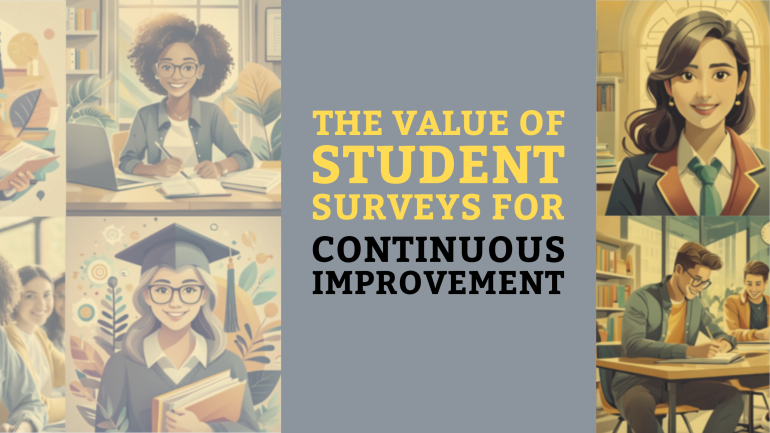Table of Contents
TL;DR: The Value of Student Surveys for Continuous Improvement
- Insightful feedback: Student surveys provide valuable insights into the strengths and weaknesses of educational programs.
- Engagement and involvement: Involving students in the feedback process can increase engagement and make them feel valued in the educational community.
- Continuous improvement: Analyzing survey data allows institutions to make data-driven decisions for continuous improvement of teaching methods and course content.
- Identification of trends: Student surveys help in identifying trends and patterns over time, enabling institutions to address recurring issues effectively.
- Enhanced student experience: By acting on survey feedback, institutions can enhance the overall student experience and create a more supportive learning environment.
There’s no denying the importance of student feedback in higher education. Student surveys serve as crucial tools for institutions to assess and enhance various aspects of their academic programs. By collecting and analyzing data from these surveys, educational institutions can identify strengths and weaknesses, address areas for improvement, and ultimately enhance the overall learning experience for students. In this blog post, we will investigate into the benefits of student surveys for continuous improvement in the education sector.
Designing Effective Student Surveys
Crafting Relevant Questions
While designing student surveys for continuous improvement, it is crucial to craft relevant questions that provide valuable insights into the student experience. Questions should be clear, specific, and directly related to the areas of interest for the institution.
Ensuring Anonymity and Confidentiality
Crafting student surveys that ensure anonymity and confidentiality is important to encourage honest and open feedback from students. Ensuring anonymity and confidentiality helps build trust with students and guarantees that their responses will not be traced back to them.
For instance, clearly stating in the survey instructions that all responses are anonymous and confidential can reassure students and increase their willingness to provide candid feedback.
Administration and Participation
There’s no denying the crucial role that student surveys play in improving the overall quality of education. These surveys provide valuable insight into the student experience, helping educational institutions identify areas for growth and development.
Timing and Frequency of Distribution
One important aspect to consider when administering student surveys is the timing and frequency of distribution. It is crucial to distribute surveys at a time when students can provide meaningful feedback, such as after completing a specific course or module. Additionally, distributing surveys regularly throughout the academic year can help track changes and trends over time.
Strategies to Maximize Response Rates
To ensure high participation rates in student surveys, institutions can implement various strategies. Providing clear communication about the purpose of the survey and how the feedback will be used can incentivize students to participate. Additionally, offering incentives such as gift cards or extra credit can further encourage students to complete the survey.
Another strategy to maximize response rates is to make the survey process as convenient as possible for students. This can include using online survey platforms that are mobile-friendly and easy to access, as well as keeping the survey short and straightforward to complete.
Data Analysis and Actionable Insights
Interpreting Survey Results
Analysis of student survey results is crucial for extracting valuable insights. Your institution can gain valuable information by looking for trends and patterns in the data. Look for recurring themes or issues that students have highlighted in their feedback. It’s necessary to interpret the data accurately to understand the current scenario and identify areas for improvement.
Implementing Changes Based on Feedback
Actionable insights from student surveys pave the way for meaningful changes in your institution. Implementing changes based on feedback shows students that their opinions are valued and can lead to a more positive learning environment. Whether it’s adjusting teaching methods, enhancing resources, or improving facilities, taking action based on survey results demonstrates a commitment to continuous improvement.
Feedback: Implementing changes based on student feedback is an ongoing process that requires a proactive approach. Institutions should not only collect data through surveys but also have a systematic plan in place to analyze the feedback, prioritize areas for improvement, and execute changes effectively. By actively engaging with survey results and making tangible improvements, institutions can foster a culture of continuous enhancement and student satisfaction.
Challenges and Considerations
Addressing Biases and Limitations
All student surveys come with inherent biases and limitations that can impact the data collected. An necessary consideration is ensuring the survey questions are clear, unbiased, and relevant to gather accurate insights. Schools must also consider factors like response rates, sample sizes, and demographics to address potential biases in the data. Employing diverse data collection methods and analyzing results carefully can help mitigate these challenges.
Continuous Improvement and Follow-up
Considerations for continuous improvement and follow-up after conducting student surveys are crucial for enhancing educational quality. It is not enough to gather feedback; institutions must also prioritize analyzing the data, identifying trends, and implementing actionable changes based on the results. Regular follow-up surveys can track progress, measure the effectiveness of interventions, and demonstrate a commitment to addressing student feedback. This iterative approach fosters a culture of continuous improvement and ensures that student voices are heard and valued.
Case Studies and Best Practices
Now let’s probe into some real-life examples of how student surveys have been utilized to drive continuous improvement in educational institutions.
- Case Study 1: A large university implemented bi-annual student surveys to gather feedback on teaching quality, facilities, and support services. Over the course of three years, the institution saw a 10% increase in student satisfaction ratings.
- Case Study 2: A community college used student surveys to identify areas for improvement in their career counseling services. By acting on the feedback received, the college saw a 20% increase in the number of students utilizing these services.
Successful Implementation Examples
For educational institutions looking to implement student surveys for continuous improvement, these examples showcase the tangible benefits that can be achieved through structured feedback collection and analysis.
Lessons Learned from Survey Responses
Responses from student surveys can provide valuable insights into areas that require attention and improvement within an institution. By carefully analyzing and acting upon survey data, educational institutions can enhance student satisfaction and overall success metrics.
Examples of insights gained from survey responses include identifying outdated course materials, ineffective teaching methods, and inadequate support services. By addressing these issues, institutions can enhance the overall student experience and drive continuous improvement efforts.
Conclusion
Presently, student surveys play a crucial role in the continuous improvement of educational institutions. By collecting feedback directly from students, schools can identify areas for enhancement, address issues promptly, and make informed decisions to enhance the overall learning experience. These surveys provide valuable insights into student satisfaction, engagement, and the effectiveness of teaching methods. Therefore, it is imperative for educational institutions to prioritize student surveys as a tool for continuous improvement and strive to create a dynamic learning environment that meets the evolving needs of students.
FAQ
Q: What are student surveys for continuous improvement?
A: Student surveys for continuous improvement are tools used by educational institutions to gather feedback from students about their experiences, satisfaction levels, and suggestions for improvement.
Q: Why are student surveys important for continuous improvement?
A: Student surveys provide valuable insights into the strengths and weaknesses of an educational program, helping institutions identify areas that need improvement and make data-driven decisions.
Q: How can student surveys benefit educational institutions?
A: Student surveys can help educational institutions enhance the quality of their programs, increase student satisfaction, improve retention rates, and ultimately boost overall performance.
Q: What are some best practices for conducting student surveys?
A: Best practices for conducting student surveys include ensuring anonymity, asking clear and relevant questions, keeping surveys concise, and providing opportunities for open-ended feedback.
Q: How can the results of student surveys be effectively used for continuous improvement?
A: The results of student surveys can be effectively used for continuous improvement by analyzing trends, identifying key areas for enhancement, developing action plans based on feedback, and communicating outcomes to stakeholders.




